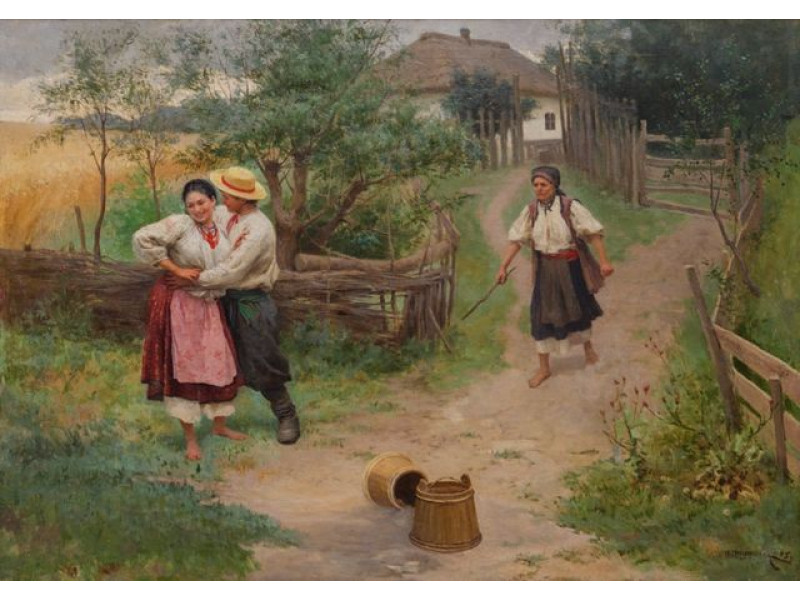In the past, the stages of a person's life were very clearly marked. Upon reaching a certain age, their status and role in society were supposed to change. In love affairs, there were also certain "norms" that society dictated.
HOLIDAYS
The period of virginity and boyhood in our ancestors began around the age of 14-15.
In winter, young people gathered in groups for evening parties or, as they were also called, dosvetki. In summer, boys and girls spent time together on the outskirts of the village, such meetings were called "streets". The formal reason for gathering at evening parties was the girls' work - spinning or embroidery. In reality, these were meetings where young people got to know each other and looked for a partner for serious and not so serious relationships. The girls had to take a position that did not involve direct manifestations of sympathy. They resorted to cunning and, in order to increase the chances of a successful marriage, demonstrated their economic skills - this was supposed to establish them as good housewives. They also demonstrated their skills in dancing, singing, and joking - this was supposed to show their cheerful and easy disposition.

Young people gathered in the home of a single woman or a family without children. An older person had to watch over the young people and make sure that the evenings were going smoothly. As payment for renting the house, the girls would make something for the hostess once a week. They also took care of the lighting, food for dinner, and the general creation of home comfort.
The boys, in turn, also demonstrated who was capable of what and brought to the party what they had made with their own hands. But, undoubtedly, their position was more advantageous than that of the girls. They could go to other parties held in the village or even visit them in the neighboring one, if the boys who lived in that village allowed them to do so. This significantly expanded the circle of potential future brides.

Sexual intercourse was strictly forbidden at these events. There is varying information about whether this rule was violated. Some eyewitnesses of those times claim that few people adhered to it and that the parties often ended in pregnancy for the girls - hence the numerous stories about the veil. It is believed that more than 60% of these youth festivities ended in pregnancy. If a young man did not want to marry a girl, there was almost no factor that could influence him to change his decision. Such a girl was considered dishonored and could not marry again.
Other stories say that boys and girls did not sleep together before the wedding. The girls understood that this, at the very least, could ruin their reputation and did not even stay until dawn at the parties, but went home to spend the night.
Such a strong discrepancy can be associated with many factors. Starting from human and geographical and ending with temporal, when years passed and the attitude towards the traditions themselves and the role of women in society changed. After all, according to data collected from observations and stories of our great-grandmothers, not even all girls understood what sexual intercourse should look like, so not everyone could identify it and perceived it simply as a form of fun.
By the way, in a public city, a young man and a young woman could only greet each other. Familiar and customary forms of affection such as kisses and hugs were strictly condemned.

There was also such a phenomenon as a brides' fair, which was held in a playful way. It dates back to the 18th century and was characteristic of the villages of Yampil region and Podillia. On Shrovetide, girls and boys came to the tavern where the innkeeper "sold" girls to the boys. This happened as follows: the "shopkeeper" praised his "goods" in every possible way and after a long bargaining sold the girls to the boys. All the proceeds from the sale were spent on vodka and partying in the tavern. After that, the girls were considered to be married, but in a joking manner. Although, in the future, many of these couples really created families.
There were also certain standards of beauty. Black and blond people were considered beautiful. On the other hand, blondes were far from the idea of beauty. And redheads, even in ethnographic records, were always described as bad and ugly. This applied to both women and men. The main markers of beauty were black eyebrows, a white face, brown eyes, a blush and a long braid.
In addition, young people had to be neither thin nor fat, because life in the village involved constant physical exertion, which both boys and girls had to perform.
GIFTS
It is difficult to imagine courtship without gifts. An example of showing interest is the ritual of girls giving Easter eggs. This was a kind of payback to the guys for the treats they gave them on Maslenitsa. Remember when the guys playfully "bought" girls? Along with the Easter eggs, the girls also gave an embroidered handkerchief with the initials of their chosen one.
There was also a custom when young men tried to remove the ring from the finger of a girl they liked. This was one of the traditional ways of courtship and a prelude to matchmaking. The guys stole the girls' jewelry: rings, scarves, ribbons. But they always returned them with new jewelry - a ring, necklace or earrings. If the girl accepted a gift from the guy, it served as confirmation of her sympathy for him and he could ask for her hand in marriage. If not, the gift was returned.
Also, at the beginning of the 20th century, toilet soap was considered a luxurious gift. In those days, people usually washed with herbal infusions for aroma, but soap was hard to come by.
MATCHMAKING
The "betrothal" period could last up to a year. Typically, the age at which a person got married was 16-17 years for girls, and 18-20 for boys. If a person did not officially have a family by that age, they were condemned. They were considered inferior and did not have the opportunity to fully function as a unit of society. An unmarried woman was not invited anywhere, it was believed that she had the wrong fate, which could have a bad influence on others.
Instead, married women had the right to participate in some rituals, and married men were allowed to participate in community meetings.
Almost always, the decisive word in the choice of a future wife and husband for young people belonged to their parents. The latter, in turn, also had criteria for selecting a partner for their children.
When choosing a wife, parents paid attention to the woman's health, since hard work in the village required a certain level of toughness and endurance. An unhealthy girl was excluded from consideration as a candidate.
Special attention was also paid to the future bride's wealth. A poor girl had significantly fewer chances of getting married in comparison. After wealth, they also considered whether the girl was a skilled housewife. They could ask neighbors or acquaintances about this.
Often, girls became hostages of their beauty, because not only young men, but also old, widowed, or sick men with good fortune were courting them. It was the latter factor that was decisive and inclined parents to make a positive decision.

The requirements for boys were almost the same. The young man had to be hardworking, healthy, and not poor. In order to determine whether the boy met these criteria, examinations were arranged. Representatives from the bride's side went to the potential groom and assessed his wealth. Sometimes the boy's parents resorted to trickery in order to appear wealthier and borrowed livestock from neighbors. In cases where they could not borrow oxen or horses, they took at least a harness and yoke and hung them in the yard or on the walls. They said, there are livestock, but now they are working in the fields.
Of course, girls and boys wanted to marry beautiful people. But if their parents had in mind to marry them to wealthy but ugly, old or crippled people, then of course they could argue, but it didn't bring any results. Although sometimes it happened that a young girl herself chose a much older man as her husband, for example, a widower, if he wasn't lazy or a drunkard. After all, she knew that she wouldn't have to be poor with him, because he already had land, a house, and a garden.
Such close attention was paid to material things, because the young people had nothing of their own before the wedding and were completely dependent on their parents. The property itself appeared only after the wedding. According to custom, the bride's parents gave the young people land, and the boy's parents - cattle. They did not go against the will of their parents, because they believed that they could curse them and a marriage with a beloved but unwanted boy would be unhappy.
By the way, a girl could also propose to a boy. This was not a very popular practice, but it was a win-win. She would come to visit a potential groom and ask the boy and his parents if he would take her as his wife, praising his beauty, skills, and advantages. The girl would not leave the house until she received consent. They were afraid to refuse her, because they believed that this could bring bad luck and her family could curse her.
Another unpopular practice was to refuse a boy's proposal. In this case, the girl would give the boy a pumpkin as a sign that she did not agree to accept the proposal. But, of course, this happened on the condition that her parents supported her in this decision.
A boy also had to ask his parents' permission before proposing to a girl. Before the official matchmaking, the parents would secretly ask her parents if they would agree to give their girl to their son, so as not to be publicly punished.

Then everything moved towards the wedding. But, that's a completely different stage of life and a topic for a separate article :)



Write a comment